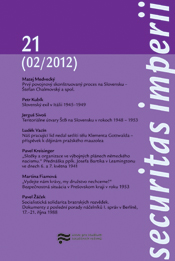Náš pracující lid nedal setlíti tělu Klementa Gottwalda – příspěvek k dějinám pražského mauzolea
„Our working people did not let the body of Klement Gottwald go off“: A paper on the history of a Prague mausoleum
Author(s): Luděk VacínSubject(s): Museology & Heritage Studies, History of Communism
Published by: Ústav pro studium totalitních režimů
Summary/Abstract: The present paper deals with the mausoleum of Klement Gottwald, the first communist president of Czechoslovakia, whose embalmed body was on display at the National Memorial on Vítkov Hill in Prague for almost nine years (late 1953–early 1962). It addresses the extravagant mythology that evolved among the people within days of Gottwald’s death. The myths claim that the body had been decomposing right from the start, and that this was the actual reason for the eventual closure of the mausoleum. These rumours are currently taken as fact by the Czech media, by Wikipedia (the Czech, English and German versions of the entry “Klement Gottwald”), and even by some scholars. The article shows that while the original rumour reflected the resentment of the Czechoslovaks towards the “Oriental” tradition of embalming communist leaders, it did not have anything to do with the reality of maintaining Gottwald’s body. The myths are disproved using hitherto overlooked archival sources, as well as the testimonies of those who were in charge of the body’s preservation. The discussion begins with a chronological overview of Gottwald’s embalming to disprove the basic premise of the mythology, that the preservation work was done too long after his death and failed. Next, the organization and tasks of the mausoleum’s non-medical staff are addressed in order to show how the mausoleum actually operated. This part is followed by an excursus into some extraordinary events, such as lab appliances failing to work, and the solutions adopted by the responsible personnel. Both the relevant archival documents and the memories of eyewitnesses unequivocally confirm that the body was intact and handled with utmost care throughout the mausoleum’s history. In conclusion, the paper analyzes the context and circumstances of the closure of the mausoleum. It shows that the decision to terminate the project was a political step inspired by Moscow, and that no considerations apart from ideological and economic ones were involved. As usual, fact eventually proves to be more interesting than myth.
Journal: Securitas imperii
- Issue Year: 2012
- Issue No: 21
- Page Range: 90-115
- Page Count: 26
- Language: Czech

